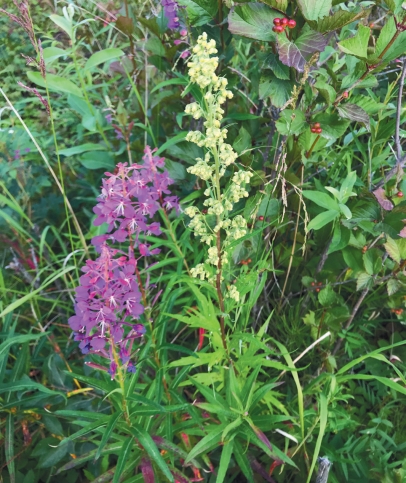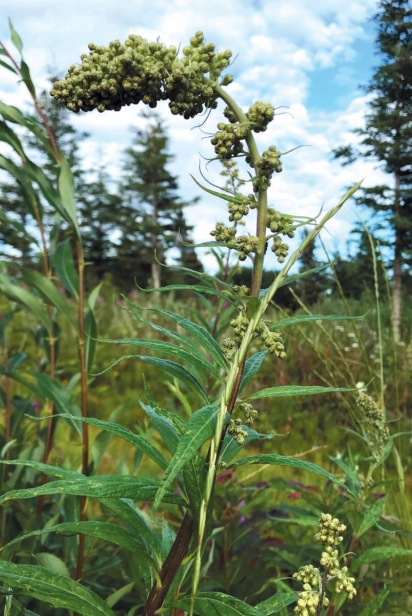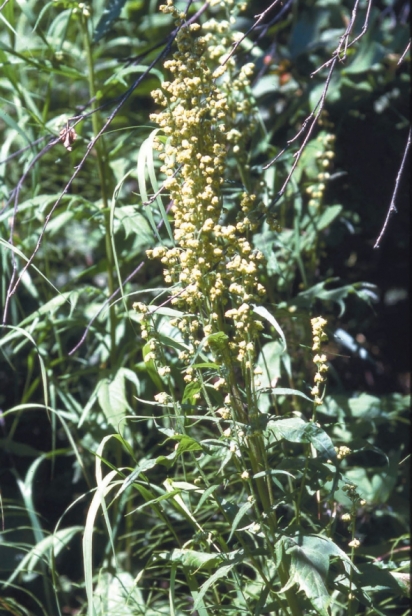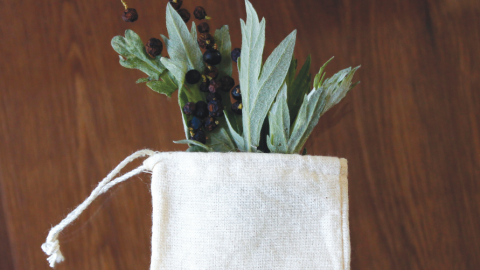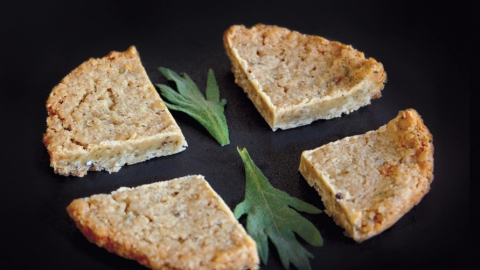Wormwood: its history and use
Its history and use
I lace up my hiking boots with a specific intention. I pack a sharp foraging knife in my backpack, center myself, and offer thanks to the land. Each year in the late summer and early fall, on a cool midafternoon after any dew or rain has evaporated, I hike up to a particular spot in the Chugach and gather wormwood. This versatile, aromatic plant has a special place in my larder due to its complex, bitter flavor and potent properties as a healing herb.
As a newcomer of white, settler heritage to Alaska, I owe my understandings of this plant to a variety of teachers and books. I first came upon wormwood when out gathering fireweed and chiming bells. Next to a patch of late blooming fireweed, I noticed some pronged leaves fluttering in the wind. Something about the plant made me curious, and I lightly pressed a silvery leaf to my nose. The potent smell cued my attention to this special plant. From the scent alone, I guessed the plant was wormwood, though I had little upon which to base my speculation other than a vague association with the smell of absinthe. I gathered a very small amount and confirmed with Janice Schofield’s Discovering Wild Plants that, indeed, this plant was wormwood, also called stinkweed or caribou leaf, as the forked leaves look like velvety caribou antlers.
Wormwood is one of more than 200 species in the genus Artemisia that includes tarragon, sagebrush, and mugwort. Wormwood and other Artemisia species have been used across the globe as medicine and as a culinary herb for thousands of years. The earliest written record is found in the Egyptian Ebers Papyrus, a medical document dated to around 1550 BC, which contains transcriptions of documents that may date back centuries prior. Eric Hulten’s Flora of Alaska and Neighboring Territories indicates that 27 species of Artemisia grow in Alaska, though not all are native to the state. One of the most common species is Artemisia tilesii, the plant I found on that first hike.
In Alaska, wormwood has a long history of powerful use as medicine by Indigenous peoples. Yaari Walker of Riiglluk Creations uses wormwood in her work as a tribal healer. Walker, who is of St. Lawrence Island Yupik heritage, came into her practice as a healer after her son fell from a cliff in 2015. Though she had been aware of the uses of wormwood and other plants prior to that time, that life-changing event called her to deepen her knowledge and bring plant medicine to heal her son and others. Walker uses Artemisia tilesii in salves for aches, pains, and irritation, teas for respiratory ailments, and burnt smudges and dried bundles over doorways to ward off negative energy.
Dr. Allison Kelliher, a family physician who practices at Snow Creek Medicine, deems wormwood or stinkweed “of ultimate importance globally” and “one of the most ubiquitous plants for use as medicine.” Dr. Kelliher holds an MD from University of Washington School of Medicine and hands on experience as a traditional Alaska Native healer. she is said to be the first Koyukon Athabascan to become a medical doctor.
Wormwood was the first plant medicine that Dr. Kelliher learned about, from teachers and family members as a young girl growing up in Nome. Her grandfather mixed it with bear grease to create a salve for aches and arthritis. Fresh leaves were used for steam. Dr. Kelliher suggests that the dried or fresh form can be steeped to use as a poultice, and the dried and fresh leaves can be rubbed between the hands and applied to the skin to ease irritation like infection. Dr. Kelliher uses the dried form for teas and tisanes, which can be preventative and have historically been used by Alaska Native peoples for various applications, including cancer. Dr. Kelliher also suggests the plant be used as an insect repellent. I personally like to rub a fresh leaf on my ankles or dab a bit of a wormwood-infused oil on my wrists and ankles. I find the scent so pleasing that I use the dry form in sachets between my stored bed linens.
Wormwood has also been used for intestinal issues including parasites, leading to its common name, though more research is needed for the plant to be used as a conventional treatment. Additional recent medical research has demonstrated it has some efficacy in supporting those with inflammatory bowel disease and Crohn’s disease. Beyond its healing potential in humans, wormwood has also been shown to help control erosion due to climate change and resource extraction. The extensive rhizome, or root structure, of the plant, and Artemisia’s hardiness to a variety of soils, can help to stabilize and restore ecological environments.
In Alaska, wormwood has a powerful history as a healing plant. Its global reputation, however, has been mired in controversy. Artemisia absinthium, or common wormwood, is a main flavoring ingredient in absinthe. Purportedly invented in 1792 by Dr. Pierre Ordinaire, absinthe was originally a medicinal tonic composed of deconcocted essential oil of wormwood and other herbs like fennel, anise, and hyssop blended with distilled spirit. The beverage received its moniker La Fée Verte, or the green fairy, for seemingly having magical curative properties.
Absinthe gained ill repute and mystique at the end of the 1800s. A more affordable beverage than wine throughout Europe, it was favored by those of lower socioeconomic status, leading to disdain from the elite. Poets and artists were also attracted to the beverage, in part for its association with romantic rituals of consumption and reputation for inducing hallucination. Due to its high alcohol content, absinthe was also favored by those looking to become intoxicated quickly. The drinking of absinthe purportedly led to “absinthism,” a condition characterized by addiction, hallucination, seizure, and even extreme violence. Vincent Van Gogh’s severed ear was reported to be one victim of this affliction. The wine industry latched on to these lurid reports and launched a smear campaign following a devastation of viniculture following a phylloxera plague. Soon, absinthe was banned throughout Europe, and in the United States where it was prohibited from 1912-2007. Blame was placed on the wormwood as an ingredient, following some dubious research at the time which involved dosing large quantities of the essential oil to animals. More recent research shows, however, that absinthism was most likely caused from consuming large quantities of the high proof beverage with its unregulated additives such as toxic copper salts used to give the beverage its green color.
Importantly, however, all species of Artemisia contain a component called thujone. This compound, also found in other herbs like tarragon and sage, can lead to adverse effects on the nervous system when consumed in high quantities. Dr. Kelliher cautions against overconsumption. Walker affirms that pregnant women should not consume wormwood. tea. The plant must be used with respect for its potency. Following the lifting of the absinthe ban, quantities of thujone present in the beverage are now regulated, though quantities of thujone in other products and foods which do not contain wormwood but use other thujone-present herbs, like sage, remain unregulated.
Since my first encounter with the plant, I have returned annually to the same location to gather, each time harvesting just a small bundle of the plant above the root. I freeze some leaves packed in parchment and dry some for later use. A precious small amount I use fresh. In addition to topical oils and scented sachets, wormwood lends itself to unique culinary preparations, where the bitter, herbaceous flavor of the plant may be honored and appreciated.
Harvesting Wormwood
Wormwood may be harvested in early summer through fall. The green plant can be gathered in summer, and the brown plant on a dry day in fall. Walker and Dr. Kelliher guide foragers to harvest honorably and with good intention. Prepare yourself for the harvest. Walker reminds that if you harvest with bad energy, that negative spirit will enter the medicine you make with the plant. She likes to take dried plants as a gift to the earth when she harvests. Dr. Kelliher, whose thoughts on harvest can also be read in a previous article on sorrel, recommends harvesting with clean hands, using a sharp knife, and gathering swiftly. No more than 20 percent of the plant community should be harvested at a time, she says, ensuring continued growth. Dr. Kelliher also encourages propagation of the plant for home garden use. The plant can be dug and relocated, splitting the source plant by half. Seeds may also be gathered in late fall for home planting.
Storing Wormwood
The leaves and stems of wormwood store well for year-round use. Hang bundles of gathered leaves and stems in a cool, dark, dry place for air drying. Dr. Kelliher recommends hanging drying plants spaced far apart with plenty of circulation on a line of twine, bundling no more than one to three plants for air drying. Wormwood may also be dried one to four hours slowly at about 90°F in a dehydrator. Dr. Kelliher recommends putting dried plants into a jar upside down and stripping leaves from stems, for an easy, messfree method. Walker reminds not to store the dried plant in plastic, as it will cause the plant to go rancid over time. Paper satchels or glass containers are best for long term storage of any plant matter.
Compilation of Indigenous Words
Anchorage Museum Education Interpretation Manager Kirk Gallardo compiled many Alaska Native words for the plant commonly called wormwood in English—visit our website to view this list of words from Inuit-Yupik-Unangan and Na-Dene language families.


